Meng Zhang
and Other Contributors
Constructing Invariant and Equivariant Operations by Symmetric Tensor Network
Aug 18, 2025Abstract:Design of neural networks that incorporate symmetry is crucial for geometric deep learning. Central to this effort is the development of invariant and equivariant operations. This works presents a systematic method for constructing valid invariant and equivariant operations. It can handle inputs and outputs in the form of Cartesian tensors with different rank, as well as spherical tensors with different types. In addition, our method features a graphical representation utilizing the symmetric tensor network, which simplifies both the proofs and constructions related to invariant and equivariant functions. We also apply this approach to design the equivariant interaction message for the geometry graph neural network, and equivariant machine learning model to learn the constitutive law of materials.
Next Edit Prediction: Learning to Predict Code Edits from Context and Interaction History
Aug 13, 2025Abstract:The rapid advancement of large language models (LLMs) has led to the widespread adoption of AI-powered coding assistants integrated into a development environment. On one hand, low-latency code completion offers completion suggestions but is fundamentally constrained to the cursor's current position. On the other hand, chat-based editing can perform complex modifications, yet forces developers to stop their work, describe the intent in natural language, which causes a context-switch away from the code. This creates a suboptimal user experience, as neither paradigm proactively predicts the developer's next edit in a sequence of related edits. To bridge this gap and provide the seamless code edit suggestion, we introduce the task of Next Edit Prediction, a novel task designed to infer developer intent from recent interaction history to predict both the location and content of the subsequent edit. Specifically, we curate a high-quality supervised fine-tuning dataset and an evaluation benchmark for the Next Edit Prediction task. Then, we conduct supervised fine-tuning on a series of models and performed a comprehensive evaluation of both the fine-tuned models and other baseline models, yielding several novel findings. This work lays the foundation for a new interaction paradigm that proactively collaborate with developers by anticipating their following action, rather than merely reacting to explicit instructions.
A Physics-informed Deep Operator for Real-Time Freeway Traffic State Estimation
Aug 11, 2025Abstract:Traffic state estimation (TSE) falls methodologically into three categories: model-driven, data-driven, and model-data dual-driven. Model-driven TSE relies on macroscopic traffic flow models originated from hydrodynamics. Data-driven TSE leverages historical sensing data and employs statistical models or machine learning methods to infer traffic state. Model-data dual-driven traffic state estimation attempts to harness the strengths of both aspects to achieve more accurate TSE. From the perspective of mathematical operator theory, TSE can be viewed as a type of operator that maps available measurements of inerested traffic state into unmeasured traffic state variables in real time. For the first time this paper proposes to study real-time freeway TSE in the idea of physics-informed deep operator network (PI-DeepONet), which is an operator-oriented architecture embedding traffic flow models based on deep neural networks. The paper has developed an extended architecture from the original PI-DeepONet. The extended architecture is featured with: (1) the acceptance of 2-D data input so as to support CNN-based computations; (2) the introduction of a nonlinear expansion layer, an attention mechanism, and a MIMO mechanism; (3) dedicated neural network design for adaptive identification of traffic flow model parameters. A traffic state estimator built on the basis of this extended PI-DeepONet architecture was evaluated with respect to a short freeway stretch of NGSIM and a large-scale urban expressway in China, along with other four baseline TSE methods. The evaluation results demonstrated that this novel TSE method outperformed the baseline methods with high-precision estimation results of flow and mean speed.
Pangu Light: Weight Re-Initialization for Pruning and Accelerating LLMs
May 26, 2025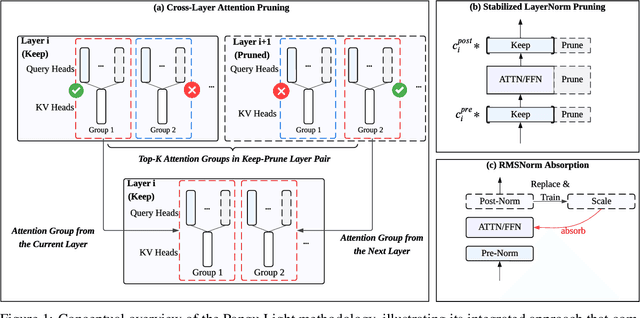

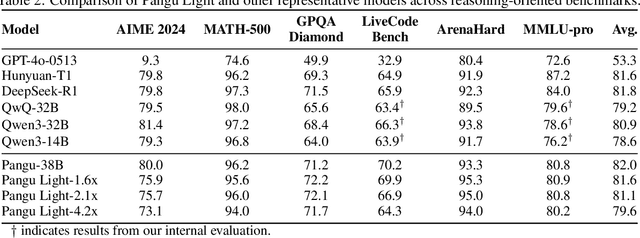
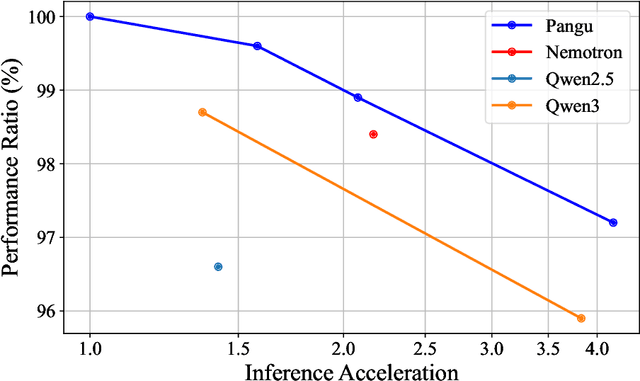
Abstract:Large Language Models (LLMs) deliver state-of-the-art capabilities across numerous tasks, but their immense size and inference costs pose significant computational challenges for practical deployment. While structured pruning offers a promising avenue for model compression, existing methods often struggle with the detrimental effects of aggressive, simultaneous width and depth reductions, leading to substantial performance degradation. This paper argues that a critical, often overlooked, aspect in making such aggressive joint pruning viable is the strategic re-initialization and adjustment of remaining weights to improve the model post-pruning training accuracies. We introduce Pangu Light, a framework for LLM acceleration centered around structured pruning coupled with novel weight re-initialization techniques designed to address this ``missing piece''. Our framework systematically targets multiple axes, including model width, depth, attention heads, and RMSNorm, with its effectiveness rooted in novel re-initialization methods like Cross-Layer Attention Pruning (CLAP) and Stabilized LayerNorm Pruning (SLNP) that mitigate performance drops by providing the network a better training starting point. Further enhancing efficiency, Pangu Light incorporates specialized optimizations such as absorbing Post-RMSNorm computations and tailors its strategies to Ascend NPU characteristics. The Pangu Light models consistently exhibit a superior accuracy-efficiency trade-off, outperforming prominent baseline pruning methods like Nemotron and established LLMs like Qwen3 series. For instance, on Ascend NPUs, Pangu Light-32B's 81.6 average score and 2585 tokens/s throughput exceed Qwen3-32B's 80.9 average score and 2225 tokens/s.
Soft Weighted Machine Unlearning
May 24, 2025Abstract:Machine unlearning, as a post-hoc processing technique, has gained widespread adoption in addressing challenges like bias mitigation and robustness enhancement, colloquially, machine unlearning for fairness and robustness. However, existing non-privacy unlearning-based solutions persist in using binary data removal framework designed for privacy-driven motivation, leading to significant information loss, a phenomenon known as over-unlearning. While over-unlearning has been largely described in many studies as primarily causing utility degradation, we investigate its fundamental causes and provide deeper insights in this work through counterfactual leave-one-out analysis. In this paper, we introduce a weighted influence function that assigns tailored weights to each sample by solving a convex quadratic programming problem analytically. Building on this, we propose a soft-weighted framework enabling fine-grained model adjustments to address the over-unlearning challenge. We demonstrate that the proposed soft-weighted scheme is versatile and can be seamlessly integrated into most existing unlearning algorithms. Extensive experiments show that in fairness- and robustness-driven tasks, the soft-weighted scheme significantly outperforms hard-weighted schemes in fairness/robustness metrics and alleviates the decline in utility metric, thereby enhancing machine unlearning algorithm as an effective correction solution.
Biomed-DPT: Dual Modality Prompt Tuning for Biomedical Vision-Language Models
May 08, 2025Abstract:Prompt learning is one of the most effective paradigms for adapting pre-trained vision-language models (VLMs) to the biomedical image classification tasks in few shot scenarios. However, most of the current prompt learning methods only used the text prompts and ignored the particular structures (such as the complex anatomical structures and subtle pathological features) in the biomedical images. In this work, we propose Biomed-DPT, a knowledge-enhanced dual modality prompt tuning technique. In designing the text prompt, Biomed-DPT constructs a dual prompt including the template-driven clinical prompts and the large language model (LLM)-driven domain-adapted prompts, then extracts the clinical knowledge from the domain-adapted prompts through the knowledge distillation technique. In designing the vision prompt, Biomed-DPT introduces the zero vector as a soft prompt to leverage attention re-weighting so that the focus on non-diagnostic regions and the recognition of non-critical pathological features are avoided. Biomed-DPT achieves an average classification accuracy of 66.14\% across 11 biomedical image datasets covering 9 modalities and 10 organs, with performance reaching 78.06\% in base classes and 75.97\% in novel classes, surpassing the Context Optimization (CoOp) method by 6.20\%, 3.78\%, and 8.04\%, respectively. Our code are available at \underline{https://github.com/Kanyooo/Biomed-DPT}.
NTIRE 2025 Challenge on Day and Night Raindrop Removal for Dual-Focused Images: Methods and Results
Apr 19, 2025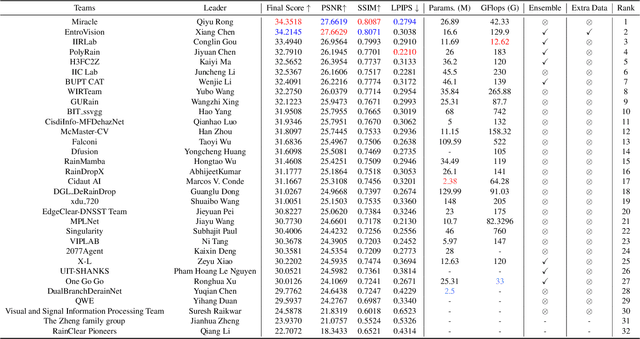
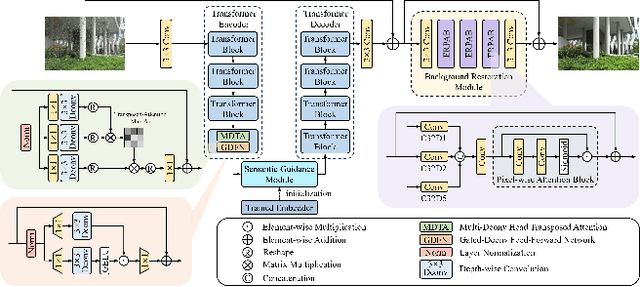
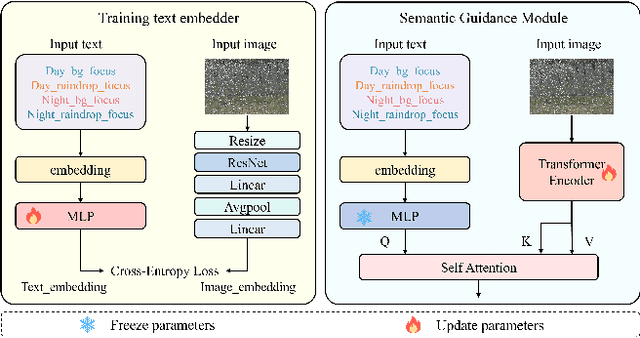
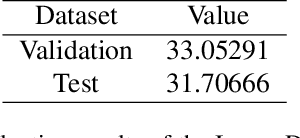
Abstract:This paper reviews the NTIRE 2025 Challenge on Day and Night Raindrop Removal for Dual-Focused Images. This challenge received a wide range of impressive solutions, which are developed and evaluated using our collected real-world Raindrop Clarity dataset. Unlike existing deraining datasets, our Raindrop Clarity dataset is more diverse and challenging in degradation types and contents, which includes day raindrop-focused, day background-focused, night raindrop-focused, and night background-focused degradations. This dataset is divided into three subsets for competition: 14,139 images for training, 240 images for validation, and 731 images for testing. The primary objective of this challenge is to establish a new and powerful benchmark for the task of removing raindrops under varying lighting and focus conditions. There are a total of 361 participants in the competition, and 32 teams submitting valid solutions and fact sheets for the final testing phase. These submissions achieved state-of-the-art (SOTA) performance on the Raindrop Clarity dataset. The project can be found at https://lixinustc.github.io/CVPR-NTIRE2025-RainDrop-Competition.github.io/.
MAPS: Multi-Fidelity AI-Augmented Photonic Simulation and Inverse Design Infrastructure
Mar 02, 2025



Abstract:Inverse design has emerged as a transformative approach for photonic device optimization, enabling the exploration of high-dimensional, non-intuitive design spaces to create ultra-compact devices and advance photonic integrated circuits (PICs) in computing and interconnects. However, practical challenges, such as suboptimal device performance, limited manufacturability, high sensitivity to variations, computational inefficiency, and lack of interpretability, have hindered its adoption in commercial hardware. Recent advancements in AI-assisted photonic simulation and design offer transformative potential, accelerating simulations and design generation by orders of magnitude over traditional numerical methods. Despite these breakthroughs, the lack of an open-source, standardized infrastructure and evaluation benchmark limits accessibility and cross-disciplinary collaboration. To address this, we introduce MAPS, a multi-fidelity AI-augmented photonic simulation and inverse design infrastructure designed to bridge this gap. MAPS features three synergistic components: (1) MAPS-Data: A dataset acquisition framework for generating multi-fidelity, richly labeled devices, providing high-quality data for AI-for-optics research. (2) MAPS-Train: A flexible AI-for-photonics training framework offering a hierarchical data loading pipeline, customizable model construction, support for data- and physics-driven losses, and comprehensive evaluations. (3) MAPS-InvDes: An advanced adjoint inverse design toolkit that abstracts complex physics but exposes flexible optimization steps, integrates pre-trained AI models, and incorporates fabrication variation models. This infrastructure MAPS provides a unified, open-source platform for developing, benchmarking, and advancing AI-assisted photonic design workflows, accelerating innovation in photonic hardware optimization and scientific machine learning.
MoE$^2$: Optimizing Collaborative Inference for Edge Large Language Models
Jan 16, 2025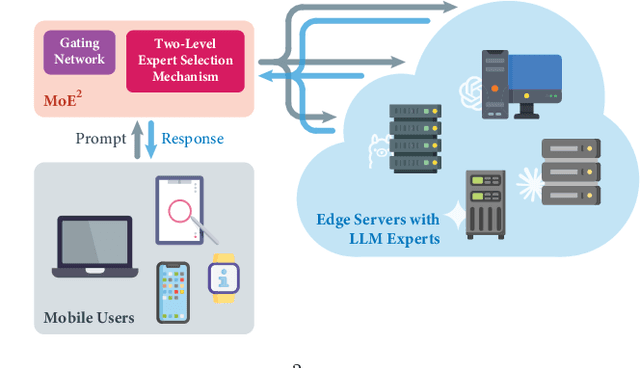



Abstract:Large language models (LLMs) have demonstrated remarkable capabilities across a wide range of natural language processing tasks. Exploiting the heterogeneous capabilities of edge LLMs is crucial for diverse emerging applications, as it enables greater cost-effectiveness and reduced latency. In this work, we introduce \textit{Mixture-of-Edge-Experts (MoE$^2$)}, a novel collaborative inference framework for edge LLMs. We formulate the joint gating and expert selection problem to optimize inference performance under energy and latency constraints. Unlike conventional MoE problems, LLM expert selection is significantly more challenging due to the combinatorial nature and the heterogeneity of edge LLMs across various attributes. To this end, we propose a two-level expert selection mechanism through which we uncover an optimality-preserving property of gating parameters across expert selections. This property enables the decomposition of the training and selection processes, significantly reducing complexity. Furthermore, we leverage the objective's monotonicity and design a discrete monotonic optimization algorithm for optimal expert selection. We implement edge servers with NVIDIA Jetson AGX Orins and NVIDIA RTX 4090 GPUs, and perform extensive experiments. Our results validate that performance improvements of various LLM models and show that our MoE$^2$ method can achieve optimal trade-offs among different delay and energy budgets, and outperforms baselines under various system resource constraints.
A Method for the Runtime Validation of AI-based Environment Perception in Automated Driving System
Dec 21, 2024



Abstract:Environment perception is a fundamental part of the dynamic driving task executed by Autonomous Driving Systems (ADS). Artificial Intelligence (AI)-based approaches have prevailed over classical techniques for realizing the environment perception. Current safety-relevant standards for automotive systems, International Organization for Standardization (ISO) 26262 and ISO 21448, assume the existence of comprehensive requirements specifications. These specifications serve as the basis on which the functionality of an automotive system can be rigorously tested and checked for compliance with safety regulations. However, AI-based perception systems do not have complete requirements specification. Instead, large datasets are used to train AI-based perception systems. This paper presents a function monitor for the functional runtime monitoring of a two-folded AI-based environment perception for ADS, based respectively on camera and LiDAR sensors. To evaluate the applicability of the function monitor, we conduct a qualitative scenario-based evaluation in a controlled laboratory environment using a model car. The evaluation results then are discussed to provide insights into the monitor's performance and its suitability for real-world applications.
 Add to Chrome
Add to Chrome Add to Firefox
Add to Firefox Add to Edge
Add to Edge